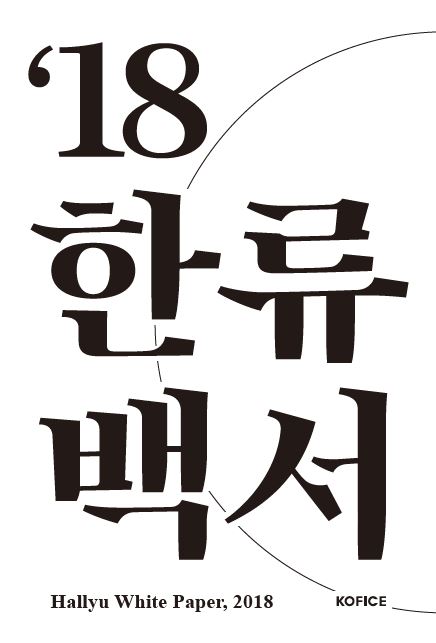2018 한류백서(Hallyu White Paper) 영문판
2019-12-06 한국국제문화교류진흥원주요내용
-

-
2018 한류백서(Hallyu White Paper) 영문판
Contents
- 1. Introduction to the Hallyu(The Korean Wave) White Paper, 2018
- 2. Hallyu, Again at the starting point
- 2.1. Hallyu and the social imaginary in the age of digital technology
(Yongjin Won Professor, Sogang University, Department of Communication)
- 2.2. Efficacy of Hallyu: beyond industry, beyond superpower
(Doobo Shim Professor, Sungshin Women’s University, Department of Media Communication)
- 2.3. Universality and particularity of K-pop as a glocal culture
(Sujeong Kim Professor, Chungnam National University, Department of Journalism and Communication Studies)
- 2.4. New media and K-pop
(Mi-yeon Kim, Director of the Kakao 1theK Studio· Seok-jeong Kwon, Kakao M PD)
- 2.5. Q&A about Hallyu, the Second Story
- Interviewee: Jong-hwan Do Poet and politician
; member of the National Assembly
; former Minister of Culture, Sports and Tourism
- Interviewer: Ah-young Kim KOFICE research team
- Interviewee: Jong-hwan Do Poet and politician
- 2.1. Hallyu and the social imaginary in the age of digital technology
목차
- 1. 2018 한류백서 총론
- 2.한류, 다시 출발점에 서다
- 2.1. 디지털 기술 시대의 사회적 상상과 한류
(원용진, 서강대학교 커뮤니케이션학부 교수)
- 2.2. 한류의 효용: 산업 너머, 강대국 너머
(심두보, 성신여자대학교 미디어커뮤니케이션학과 교수)
- 2.3. 글로컬Glocal 문화로서 케이팝의 보편성과 독특성
(김수정, 충남대학교 신문방송학과 교수)
- 2.4. 뉴미디어와 케이팝
(김미연, 카카오M 원더케이스튜디오 국장 · 권석정, 카카오M PD)
- 2.5. Q&A about 한류 직문직답, 그 두 번째 이야기
- 인터뷰이: 도종환, 前 문화체육관광부 장관
- 인터뷰어: 김아영, 한국국제문화교류진흥원 조사연구팀 연구원
- 2.1. 디지털 기술 시대의 사회적 상상과 한류
개요
- The exports of broadcasting contents in 2018 were driven by programme providers and production companies. While the number of exports for terrestrial broadcasting stations decreased by an annual average of 7.9% (approximately KRW 197.97888 billion between 2013 and 2017), that for programme providers increased by 20.6% (approximately KRW 126.23424 billion) and independent programme productions by 31.7% (approximately KRW 87.18336 billion) in the same period. This indicates that while terrestrial broadcasting stations had accounted for most of the exports of broadcasting contents, the proportion has been recently decreasing.
※ 자세한 내용은 첨부(PDF)파일을 참고하시기 바랍니다.
- 해당장르 :
- 전체장르
- 해당국가 :
- 기타

